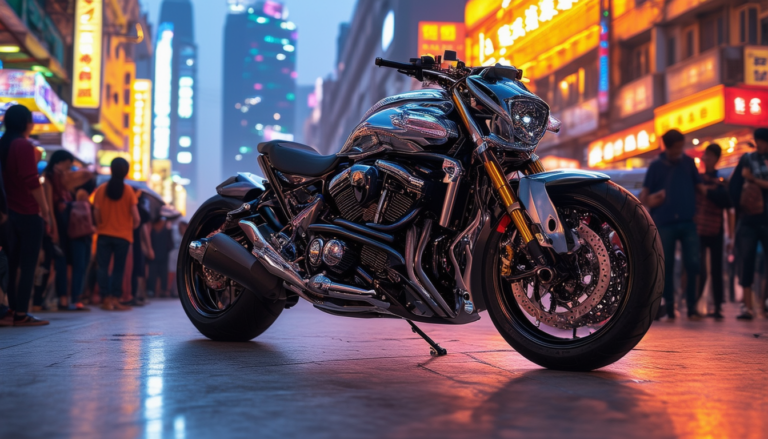Germany’s motorcycle market sees explosive growth, surpassing 5 million bikes sold

As of January 1, 2025, the motorcycle market in Germany has reached a significant milestone with over five million registered motorcycles, reflecting an exciting chapter in European two-wheeler culture. From Bavaria to North Rhine-Westphalia, the passion for motorcycles, fueled by strategic purchases ahead of stricter emissions regulations, showcases Germany’s dynamic embrace of two-wheel mobility. This explosive growth is not just about numbers; it’s a celebration of a deep-rooted enthusiasm for riding that spans both practical urban commutes and thrilling alpine adventures.
Germany’s motorcycle market is experiencing a remarkable surge, with the country recently surpassing the impressive milestone of over 5 million registered bikes. This growth reflects a combination of changing consumer preferences, strategic pricing due to upcoming regulations, and a deep-rooted culture of embracing two-wheelers for various purposes, from commuting to leisure. As manufacturers like BMW, Piaggio, Yamaha, and others lead the way, German riders are buzzing with enthusiasm, eager to embrace the freedom and efficiency motorcycles offer in both urban and rural settings.
The Rise of Two-Wheelers in Germany
The role of motorcycles and scooters in Germany has expanded rapidly, proving that two-wheelers are more than just recreational vehicles. With over five million registered bikes as of January 1, 2025, motorcycles are integral to the country’s mobility scene, offering solutions for both daily commutes and weekend adventures. This fervor for two-wheelers is evident in cities and countryside alike, where motorcycles help navigate traffic and evade high parking fees.
Bavaria: Leading the Charge
Among the various regions, Bavaria stands out with an impressive 1,079,282 registered motorcycles, proving its dominance despite not being the most populous state. It sets the pace for the rest of Germany in embracing motorcycle culture, effectively blending tradition with modern needs. North Rhine-Westphalia and Baden-Württemberg are not far behind, securing their positions with 947,291 and 784,427 bikes, respectively. Even regions with smaller populations, like Hesse, contribute significantly to the numbers.
Impact of Euro 5+ Regulations
The rush to purchase motorcycles before the enforcement of stricter Euro 5+ emissions regulations has been a major catalyst in this growth. Manufacturers offered enticing deals on Euro 5 models to clear their inventory, prompting a surge in registrations. These promotional strategies, combined with the practicality motorcycles offer in congested urban areas, have solidified their status as a preferred mode of transport.
Top Brands in the Market
Among the most popular brands, BMW reigns supreme, boasting 650,864 registered bikes across the country. The homegrown brand’s reputation for adventure and touring motorcycles is a significant factor in its success. Piaggio, largely thanks to the iconic Vespa, claims the second spot, while Yamaha and Suzuki hold strong positions with 474,836 and 439,326 bikes, respectively. Interestingly, Honda, the world’s largest motorcycle manufacturer, ranks fifth in Germany, a testament to the localized brand loyalties present in the market.
KTM: A Cautionary Tale
While many brands celebrate their success, KTM’s struggles serve as a warning about the volatile nature of the industry. Once on the brink of collapse with a debt nearing 2.9 billion euros, KTM is undergoing a restructuring process. Although the brand is trying to reassure consumers and investors of its recovery, skepticism lingers. This situation underlines the importance of strategic decision-making in maintaining a brand’s stability and reputation in the fluctuating motorcycle market.
Conclusion: An Evolving Landscape
Germany’s achievement of exceeding five million motorcycles is more than just a numeric milestone. It signifies the robust motorcycle culture entrenched in the nation’s heart. As riders continue to embrace bikes for various needs, there lies an implicit challenge: how long until Germany crosses the six-million mark? The dynamic interplay of regulations, consumer tendencies, and brand strategies keeps the German motorcycle industry vibrant and ever-evolving.
Germany’s motorcycle market has recently achieved a remarkable milestone, with over 5 million registered bikes as of January 1, 2025. This phenomenal growth is driven by a strong motorcycle culture, strategic market shifts, and the anticipation of new emissions regulations. This article dives into the factors behind this expansion, popular brands leading the race, and what the future holds for Germany’s thriving two-wheeled community.
Germany’s Motorcycle Culture and Historical Growth
Motorcycles and scooters have always been integral to daily life in Europe, with Germany being no exception. From Alpine trails to bustling city streets, two-wheelers offer both thrill and practicality. Back in 2021, the country recorded around 4.5 million registered two-wheelers, edging close to 5 million by 2023. Now, with over 5 million bikes on the road, it’s clear that Germany’s love for motorcycles is more profound than ever.
Leading the Charge: Bavaria and Others
Leading this two-wheeled revolution is Bavaria with 1,079,282 registered motorcycles, despite not being Germany’s most populated state. This is followed by North Rhine-Westphalia with 947,291 and Baden-Württemberg with 784,427. Even smaller states like Hesse boast a notable 368,859 bikes, showcasing the widespread adoption across the nation.
Factors Driving the Growth
One significant factor behind this growth is the rush to purchase motorcycles before the introduction of Euro 5+ emissions regulations. Anticipating the changes, manufacturers reduced prices on existing Euro 5 models, enticing buyers to capitalize on attractive deals. Additionally, as cities become more congested and public transport costs rise, motorcycles remain an effective solution for urban mobility.
Brand Wars: BMW Dominates in Germany
In terms of brand popularity, BMW stands out with 650,864 registered motorcycles across Germany. This success is hardly surprising given the brand’s homegrown status and strong selection of adventure and touring motorcycles. Following BMW, Piaggio enjoys its place in the market thanks to the Vespa—an icon among European city riders.
The Struggles of KTM
While many brands are thriving, KTM faces its own set of challenges. Once on the brink of collapse due to financial woes, KTM is undergoing restructuring. Despite assurances of improvement, the brand’s stability is still under scrutiny. This situation highlights how quickly the dynamics of the motorcycle market can change, reinforcing the importance of sound business decisions.
The Road Ahead
Germany surpassing the five-million mark is not just about the numbers—it’s a testament to the country’s dedication to motorcycle culture. With ongoing changes in regulations and market trends, the landscape continues to evolve. Riders across Germany keep the spirit alive, from the rush of the Autobahn to peaceful Sunday rides. The exciting question now remains: When will Germany reach six million?






